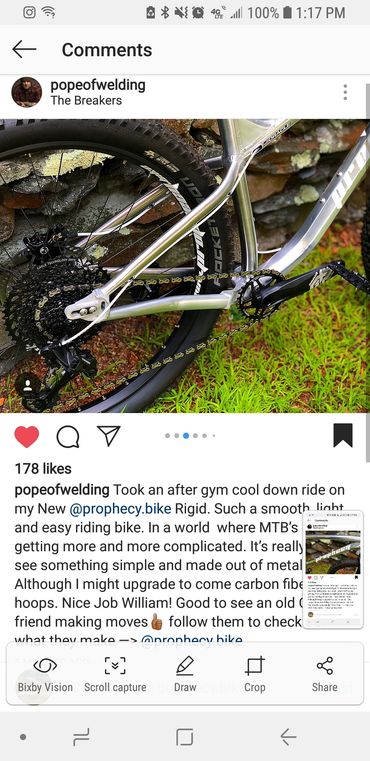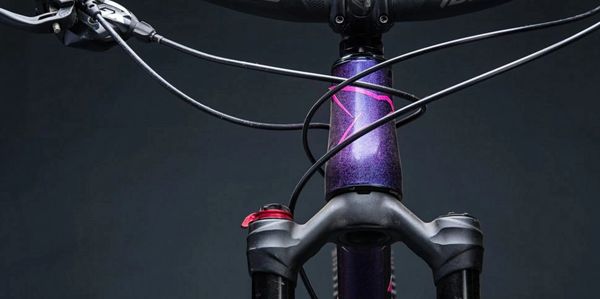Vanilla Gorilla - Jesse James






tested: prophecy oracle - Travis Engle, Bike Mag
Reprinted without permission

The hardtail can be so many things. It can be a race machine, a dirt jumper or a gravel grinder. It was just a gateway drug for some, and it's just a backup bike for others. But for the dreamers, it's a canvas. The hardtail is a blank slate that anyone with an imagination and a torch can walk up to and wind out a fantasy like a clown making a balloon animal. It's simple, universal, and unpatentable. That's why it's stock-in-trade for small brands looking to explore new territories in geometry and design. Prophecy Bikes' debut model, the Oracle, does exactly that, but not in any way I would have expected.
The Oracle is the brainchild of Mike Foxworthy and William Kenefick. Most of Kenefick's two-wheeled creations weigh 350 pounds, have 250 horsepower and look a bit like they might turn into alien robots as soon as you're not watching. In fact, three of them did exactly that when they were featured in the first Transformers sequel in 2009. But Kenefick didn't tell me anything about that part when we met. I had to Google it. Although his extensive experience making custom motos informed some of his choices in the Oracle's creation, Prophecy is really just about him building the bike he wanted to ride.

For my test rig, that meant a technical-terrain-oriented alloy hardtail built around 27.5×2.8-inch tires. But it will fit up to a 29×3.0 thanks to the 20 millimeters of adjustment in its sliding dropouts. At its shortest, the rear center measures 415 millimeters, making it 435 at its longest. If you're part of the .08 percent of riders out there interested in running 29-plus tires, 435 is pretty impressive. The Trek Stache beats that by 15 millimeters, but only by elevating the drive-side chainstay, which costs the bike some stiffness. Instead, the Oracle maintains a traditional shape with the help of an innovative single-sided chainstay yoke that keeps it light and stiff on the non-drive side, but offers enough real estate on the drive side for near bottom-bracket-scraping tire tuck.
The straight line from the Oracle's axle to its head tube is meant to keep pedal and pumping forces going directly to the rear wheel, although I've never ridden an aluminum hardtail I've found lacking in vertical stiffness. Maybe more importantly, it was meant to look cool. And the Oracle definitely does look cool. Part of that is its blindingly sparkly "Illusion Purple" paint scheme. And if that's a little much for you, Prophecy offers literally thousands of color options and several matching frame/fork/rim decal colors. The results are pretty striking. Every time I bring home a test bike, it comes with on my nine-mile commute from the Bike offices to the train station. I've done it on countless boutique full suspension masterpieces, and never have they drawn a single "nice bike" from a passerby. But it happened twice on the Oracle.
Prophecy offers deeply customizable build kits on top of its custom paint. We went mostly off-the-shelf with our test bike. The GX Eagle drivetrain, Stan's rims, Race Face cockpit and post are pretty standard stuff. Kenefick is fond of Magura from his experience with the brand’s motorcycle systems. And then, soon after I started testing this bike, Prophecy struck a deal with RockShox to bring the price of its Pike fork upgrade down, making it a more ideal mate than the Manitou Machete seen on the $3,000 build you see here. Or, there’s a base-level build for $2,000 with NX Eagle, MT2 brakes and a Rock Shox Sektor fork. The Pike fork alone is definitely worth the upgrade, but the Manitou doesn't ride half bad.

Neither does the bike itself, once I found its happy place. This is a bit of a paradox, but, in a nutshell, the Oracle is a playful plus bike. I rode it primarily with the dropouts slammed at their shortest length, and that played to its strengths. Combine that with its low standover, and you've got the feeling you're on a bmx bike, just one with loads of traction and 140 millimeters of front travel. Also vaguely reminiscent of my 20-inch days is the Oracle's particularly short reach measurement. I tested a large, and it stretched just 440 horizontal millimeters between pedals and headset. That's a little tight for a medium among some aggressive hardtails. The bike feels short, and there's no XL to size up to. This was no accident, though. Prophecy is deliberately bucking the trend of two-wheeled limousines like the Kona Honzo. An illustration William Kenefick offered to explain this was that, if you hold a ten-pound weight close to your chest, you have more strength than out at arm's length. It made an odd sort of sense in my head, even though that head sits six feet, two inches off the ground.
After my initial set-up ride on it, I took it on a rocky, loose and dry shuttle. The route is a mixed bag, but the bulk of the trails are the kind that, on the right hardtail, can be plenty of fun. Maybe a masochistic, thank-you-sir-may-I-have-another sort of fun, but still fun. Then, while the trail was paddling the Oracle on the ass like an Omega-house fraternity brother, I found it was a bit of struggle to keep it in line. I spent some time with the dropouts slid back, and that helped mitigate the deflection, but that short span between my feet and hands made it difficult to keep my weight where I wanted over the bike. After 3,000 feet of that, I realized I needed a change of venue.
There's a network of trails higher up in the San Gabriel Mountains that are dotted with Volkswagen-sized (and -shaped) boulders separated by smooth, slide-y decomposed granite and punctuated by slow, behind-the-sadde techy chutes. It's a choose-your-own adventure, living trials course, and one that's not easy to access. It's perfect for an adventure hardtail that likes to be told what to do. Suddenly, I was at home on the Oracle. It was a new feeling to combine the traction and forgiveness of 2.8-inch tires with the responsiveness of a BMX bike. The moderate-by-today’s-standards 66.5-degree head angle further played to that responsiveness without ever feeling twitchy. Every fifty feet, there was an opportunity to get rad with it. It was easy to get my weight behind the bike to get it into a manual, or quickly upward to get it into the air. The short reach that was a liability on the high-speed chunder was an asset on the natural skatepark I eventually made my way to. It's fun-focused and playful in a way that no other plus-sized hardtail quite pulls off. And that's entirely because this bike is not here to chase trends. The Oracle is another example of why the hardtail is such fertile ground for new ideas.
Top Ten reasons to get a hardtail
How Hard Can You Ride On A Hardtail Mountain Bike?
GMBN Hardtail Confidence